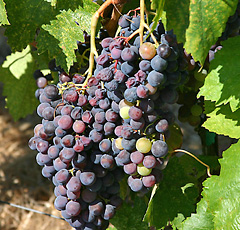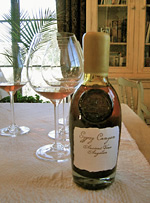The Mission Grape: A Taste of History - November 16, 2006

|
Some of the most dull, insipid wines I've had over the years have been made from the Mission grape variety. A couple of the most incredible dessert wines I've had have also been made from Mission. In today's column, we'll explore some of the wines made from this historical grape. I've long had an interest in Mission since I first had a few California Angelicas in the mid '70's. My interest was piqued again when I read "Origins and Early Development of New Mexico's Wine Industry" by noted Los Alamos historian Paul Kraemer that appeared in "La Cronica", the New Mexico Historical Society quarterly. In it, he recounts the large role Mission plays in early New Mexico. In fact, Mission in New Mexico predates its appearance in California. Not surprisingly, the origins and history of the Mission grape are uncertain. The literature is rife with conflicting claims. Much of this could be definitively answered by DNA typing, yet virtually none has been done because of lack of financial support.
The Mission grape was probably brought to Mexico from Spain by the conquistadors in the mid-1500's. It may have been taken to Chile and Argentina before that. The early Castilian grapes that Cortes brought fared poorly in central New Spain. Sometime in the late 1500's, there was a thriving grape industry in central Mexico, in an area known as Parras ("grape vines"), but the varieties and their origins are unknown. These vines were labeled as Criolla (meaning "born in the New World of European origin").
There is some speculation that these vines may have originated not as cuttings from Spain, but
propagated from grape seeds, a method that does not insure genetic purity. There is some speculation that Criolla may be a hybrid between Castilian grapes and native grapes indigenous to Parras. Harold Olmo, noted UC/Davis grape expert, speculates that California's Mission may be a hybrid between the Criolla/Mission grape and native species in California. At any rate, Criolla/Mission is now classified as a member of the vitis vinifera family. DNA typing could answer that for certain. But it gets even more complicated. There is some evidence linking Mission to a variety from Spain and Sardinia known as Monica. Monica is not known in Spain today. In Argentina, there are two widely planted varieties, Criolla Chica and Criolla Cereza. It is claimed that the Pais grape of Chile is "related to" or a "sub-variety" of the Mission grape. So who really knows?
 |
Kraemer notes that Criolla cuttings were brought to New Mexico in 1629, predating Father Junipero Sierra's planting of Mission/Criolla at Mission San Diego in 1769 by nearly 150 years. These plantings were located at the pueblo of Senecu, south of present-day Socorro. Much documentation was lost on this early New Mexico viticulture in the Pueblo Revolt of 1680. Two hundred years later, the Socorro area was the center of the New Mexico wine industry, in the early 1800's.
In the 1720's, the El Paso area was known to be an important grape growing area, rivaling that of Parras. By the late 1700's, grape growing had spread to the Isleta/Belen area and even as far north as Bernallilo. In the mid-1800's, grapes had spread to the Tularosa Basin, now an important wine growing area and home of New Mexico's only Mission wine. Shortly thereafter, grapes spread to the Mesilla Valley near Las Cruces. By the late 1800's, the Criolla/Mission grape was falling into disfavor and imported European varieties were taking their place. Some of these were probably brought to Santa Fe by Bishop Lamy from his native Auvergne and nearby Burgundy around 1870. Again, documentation is scanty.
Meanwhile, the johnny-come-latelys in California were propagating their Mission vines up the
coast in California as they spread their mission network northward. By the early-mid 1800's, Mission
was the dominant California grape.
So.... what about wine from the Mission grape?? By and large, it's pretty miserable as a dry table
wine. Though a dark-skinned grape, the phenolics are weak and the coloring of the wine is low and
unstable. The grape is notoriously low in acid and makes for dull, flabby wines of weak color and very short lived. Thus there is very little Mission wine made now and the plantings have dwindled
to near-nothing.
However....those early friars knew a thing or two about wine and what they liked. They recognized
that keeping residual sugar in the wine was the secret to prolonging its life. They made a wine they
called Angelica by adding grape brandy to the Mission grape juice, resulting in a very sweet wine
of about 20% alcohol. In the France's Champagne region, they make the same kind of wine from Pinot Noir juice, where it is known as Ratafia. In the Cognac region, they similarly make Pineau de
Charentes.
The wines are very sweet when young and not very good. But with (much) time, they can be
transformed into an amazingly complex dessert wine. Usually they are aged in large glass carboys or
very old, neutral oak barrels. As they age, the sweetness level drops and they develop a beautiful
dark brown color...and wonderfully complex aromatics.
 |
I have had a Heitz Cellars Angelica, made from old stocks purchased from East Side Winery (now defunct) in Lodi, of vintage 1875, that was one of the most incredibly dessert wines ever. Served with a 20 year old fruit cake topped with Creme Anglais, it's a magical dessert pairing. San Martin Winery used to bottle an Angelica they called Montonico, from old stocks, that was lovely. Alas, Angelica is a genre that has nearly vanished in California. You have to be in it for the long haul. In 1994, Deborah Hall bought property in Santa Barbara's Santa Rita Hills, a stone's throw from Lompoc's restored La Purisima mission. Upon a hillside covered with scrub oak and underbrush, she discovered an old Mission vineyard of gnarled vines that probably dates back to the mid-1800's, maybe earlier. She resurrected the vineyard and is now making classic, old-style Angelica under her Gypsy Canyon label (www.gypsycanyon.com), priced at $120 per half bottle.
There are a few other dessert Mission wines being made in California. Charlie Meyer's Harbor Winery Mission Del Sol comes from very old vines in the Deaver Vineyard in the Shenandoah Valley. It's one of the best. There remain a handful of dry Mission wines still being made in the Sierra Foothills. They are more of historical and intellectual interest than of great drinking pleasure.
Closer to home, Tularosa Vineyards (www.TularosaVineyards.com) makes a Mission table wine.
Dave Wickham took cuttings from a very old backyard Mission vine in nearby La Luz and propagated
it into his home vineyard in 1985. The wine is off-dry and has a slight nutty/sherry character
with a nice spiciness. It makes a very nice aperitif wine with Marcona almonds and dense
fig cake. One can almost imagine sitting down with the friars in Socorro in the 1700's and knocking
back a few glasses of it in a less than reverent fashion.
Grape vines are very hardy plants and can go for years and years with neglect. It would not be
the least bit surprising to find scattered about in backyards or alongside irrigation ditches in
Bernallilo, Socorro, Belen, the Mesilla Valley, or other locales of grape growing in old New Mexico
a few ancient Mission vines. One can only wonder the stories they would have to tell.
